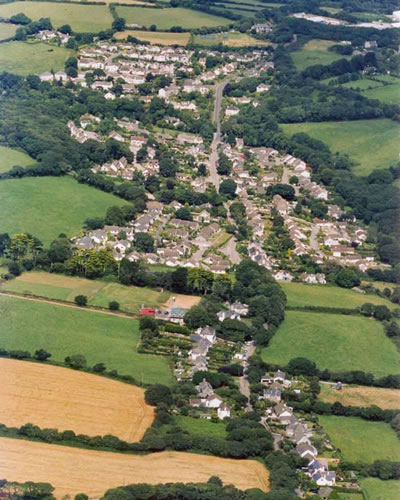About the Parish

Aerial view of Budock Water
The parish of St. Budoc, in the manor of Treliever, was mentioned in the Domesday Book of 1085 and the earliest recorded rector of Budock Parish was John de Plesseto in 1207. Budock Parish is, therefore, considerably older than its larger neighbours of Falmouth (town founded by Sir John Killigrew in 1661) and Penryn (founded by Bishop Simon in 1216).
The oldest documented boundary was written up in an old Budock Vestry Register on 24th May 1677, as ” West from Mainporth to Penwarne, to a rocke that lyes in the lane northwards from the white wall, and from thence to a rocke in Troune Moore, which lyes between Constanton, Mawnon and Budocke, from thence to an old lane which joins with Rosecolas, from thence to a river that comes from James Davas, his mills called Anter Water, which devids Budocke and Mabe, and from thence to the Colledge”.
This ancient boundary had the Church of St. Budock in the centre, and included what is now the town of Falmouth, Pendennis Castle and part of Penryn. In 1661, an Act of Parliament separated Falmouth from Budock Parish, and in 1934, the Ponsharden / Glasney area became part of Penryn.
Nowadays, Budock Parish extends to 2,388 acres, with a population of approximately 1,200, and lies between Mabe & Penryn to the north, Falmouth to the east, Mawnan to the south and Constantine to the west. The village of Budock Water, with its Parish Church, is near its centre with Lamanva and Treverva approximately 3 miles to the west.
Budock Water
The village nestles in the shelter of Trewen Downs. Trees grow by the stream which flows under the main road, and on to the sea at Maenporth Beach. For St Budock Parish Church, follow Churchtown, a small road on your left, before you reach the village. In the centre of Budock Water are the Village Hall, General Store and the Trelowarren Arms public house, outside of which was the site of the old village pump which now has a small garden and seating area.
Treverva
Almost certainly originally a single farm with workers’ cottages, Treverva grew into a small village at a road junction. It was once a thriving village of mainly granite workers, a busy place with granite being hauled by horse from quarries to Freeman’s Wharf in Penryn. It is now a much smaller settlement. The valley between Treverva and Mabe was flooded to create Argal Reservoir, of which there are magnificent views from the road through the village.
Lamanva
A very small village, Lamanva was undoubtedly originally a single farm. In days gone by there was a granite quarry here along with a drovers’ inn. The village was once home to a famous Military Museum (now transferred to Flambards near Helston) which also kept ostriches (also moved to The Lizard).
Download Documents:
- Useful information for new residents of Treverva and Lamanva
- Lamanva History
- Treverva History
- Treverva & Lamanva Spring 2025 Newsletter
- Treverva & Lamanva Summer 2023 Newsletter
- Treverva & Lamanva Spring 2023 Newsletter
- Treverva & Lamanva Winter Newsletter 2022
- Treverva Village Hall AGM Minutes 17 Oct 2022
- Treverva Village Hall Minutes & AGM 17th October 2022
- Treverva Village Hall Minutes 25 April 2022
- Treverva Village Hall Minutes 31 January 2022
- Treverva Village Hall AGM Minutes 18 Oct 2021
- Treverva Village Hall Minutes 29 April 2021
